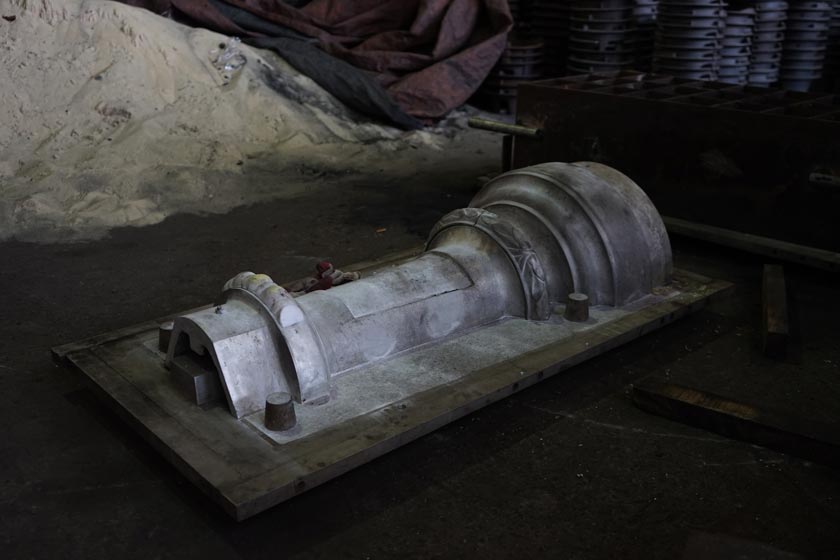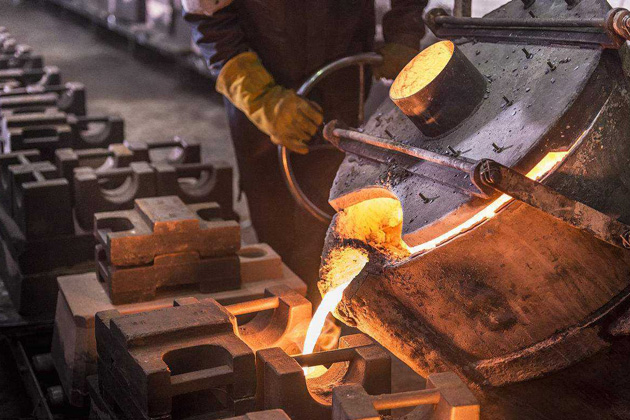How Aluminum Foundry Adds To Advancements in Aerospace Design
Aluminum factories are integral to advancements in aerospace engineering. They produce light-weight, high-strength components that are essential for contemporary aircraft. With advanced spreading methods, these foundries create complicated geometries that enhance structural stability. Furthermore, the growth of superior Aluminum alloys supports the market's emphasis on gas performance and sustainability. Challenges continue to be in the production procedure. Recognizing these factors exposes the extensive influence of Aluminum on aviation's future.
The Value of Lightweight Materials in Aerospace Style
As the aerospace sector remains to progress, the importance of lightweight products ends up being significantly obvious. The need for effectiveness and sustainability drives designers to focus on the usage of materials that minimize total weight without compromising structural stability. Lightweight products, especially Aluminum, play a crucial duty in boosting fuel efficiency, improving haul ability, and boosting the total efficiency of aircraft.
Furthermore, the assimilation of these materials permits innovative layouts, making it possible for suppliers to produce even more aerodynamic forms that can stand up to extreme conditions. The decrease in weight not just lowers functional expenses however likewise adds to a decreased environmental impact, aligning with international initiatives toward sustainability in aeronautics.
Advanced Spreading Techniques in Aluminum Foundries
Advanced spreading techniques in Aluminum factories play a vital function in aerospace design by allowing the production of light-weight and specific elements. Innovations in mold and mildew style and precision spreading processes are vital in attaining suitable efficiency and structural honesty. Furthermore, the growth of light-weight alloys improves the general efficiency and performance of aerospace applications.
Innovative Mold Layout
Cutting-edge mold layout plays an important duty in the efficiency and performance of Aluminum factories, specifically within the aerospace market. By leveraging innovative materials and methods, contemporary mold and mildews can be crafted to endure high temperatures and stress, guaranteeing peak performance during the casting process. These designs commonly incorporate complicated geometries that enable the production of light-weight yet structurally sound parts, important for aerospace applications. Furthermore, using computer-aided layout (CAD) software program helps with precise modeling, enabling shops to fine-tune and simulate mold designs before physical manufacturing starts. This not just boosts the top quality of cast parts however also lowers waste and preparation, leading to considerable cost financial savings. In general, cutting-edge mold design is a foundation of progression in Aluminum Foundry innovation for aerospace engineering.
Accuracy Casting Procedures
The performance of innovative mold styles effortlessly incorporates with accuracy spreading procedures, which are essential for producing high-grade Aluminum elements in aerospace engineering. These procedures, consisting of sand spreading, die spreading, and financial investment casting, ensure the production of intricate geometries with tight tolerances. Advanced methods like vacuum cleaner spreading and stress pass away casting enhance the integrity and surface coating of the end products. Accuracy casting minimizes product waste while maximizing the mechanical residential properties of Aluminum, critical for aerospace applications. On top of that, employing real-time tracking and advanced simulation devices during the casting process allows for prompt modifications, causing improved high quality control. Collectively, these precision spreading procedures setting Aluminum shops at the center of aerospace innovation, sustaining the market's need for integrity and efficiency.
Lightweight Alloy Growth
As aerospace engineers seek to improve fuel efficiency and performance, light-weight alloy growth comes to be an important focus in Aluminum foundries. These foundries use innovative spreading techniques to produce alloys that provide premium strength-to-weight proportions. Developments in alloy structure, consisting of the consolidation of aspects like lithium and magnesium, allow the manufacturing of products that hold up against extreme conditions while decreasing general aircraft weight. Strategies such as die casting and financial investment spreading promote the accuracy manufacturing of complicated shapes, which are critical for aerospace applications. Furthermore, continuous research study aims to maximize these alloys for enhanced mechanical residential or commercial properties and raised durability. By prioritizing light-weight alloy advancement, Aluminum shops significantly contribute to the evolution of aerospace engineering, leading the way for more effective and lasting airplane styles.

Enhancing Architectural Honesty Via Aluminum Components
Aluminum elements use significant advantages in improving architectural stability within aerospace design. Their lightweight nature contributes to general efficiency while keeping toughness, which is crucial for aircraft efficiency. Additionally, the stress and anxiety resistance buildings of Aluminum help ensure the sturdiness and dependability of aerospace frameworks under numerous operational problems.
Light-weight Material Conveniences
While conventional products often endanger weight for stamina, making use of Aluminum parts in aerospace design offers considerable advantages in structural honesty. Aluminum's lightweight nature contributes to general layout performance, permitting more streamlined aircraft that consume less gas, consequently improving sustainability. The product's superb strength-to-weight ratio assurances that parts preserve durability without including unneeded mass. This high quality fosters boosted efficiency and agility in flight, in addition to maximized haul capabilities. In straight from the source addition, Aluminum's resistance to rust lengthens the life-span of aerospace frameworks, lowering maintenance prices and improving safety. As makers significantly adopt Aluminum alloys, the aerospace market experiences a transformative shift towards extra reliable and efficient design options that focus on both efficiency and ecological obligation.
Stress Resistance Characteristics
Numerous materials possess special homes, Aluminum's remarkable stress resistance stands out as an essential factor in enhancing the architectural stability of aerospace components. This resistance plays a crucial duty in guaranteeing that aircraft can hold up against different operational stress and anxieties, including exhaustion, influence, and ecological conditions. Aluminum alloys, specifically engineered for aerospace applications, display high tensile toughness while keeping lightweight features, enabling designers to develop more reliable frameworks - Aluminum Foundry. In addition, the ability of Aluminum to sustain cyclic loading without substantial contortion adds to the longevity and integrity of aerospace components. As improvements proceed in Aluminum Foundry methods, the growth of stress-resistant Aluminum parts promises additional improvements in performance, security, and effectiveness across the aerospace industry, solidifying Aluminum's function as a preferred material in modern-day engineering
Gas Efficiency Improvements Driven by Aluminum Innovations
As the aerospace sector seeks to boost gas performance, cutting-edge uses Aluminum have actually emerged as a necessary service. Aluminum's light-weight nature notably reduces aircraft weight, allowing for reduced gas intake during trip. This reduction in weight is essential, as even tiny declines can result in significant improvements in general fuel economy.
Advanced Aluminum alloys, made for improved strength and sturdiness, enable producers to produce elements that maintain structural stability while lessening mass - Aluminum Foundry. Additionally, the combination of Aluminum in airframes and engine components helps with enhanced the rules of aerodynamics, adding to minimized drag and enhanced efficiency
The adoption of Aluminum in aerospace not only meets the demand for fuel-efficient layout yet also lines up with governing stress for lower exhausts. As these developments remain to advance, they play a substantial role in setting brand-new standards for fuel effectiveness, ensuring that the aerospace industry can fulfill growing environmental and financial challenges.

The Function of Aluminum in Sustainable Air Travel Practices
The enhancing emphasis on lasting aviation practices has positioned Aluminum as an essential material in the pursuit for greener airplane design. Known for its lightweight residential properties, Aluminum substantially reduces aircraft weight, causing lower gas consumption and exhausts. Its recyclability even more boosts its sustainability profile, as Aluminum can be reused indefinitely without loss of quality. This particular supports a circular economy within the air travel industry, lessening waste and resource depletion.
Moreover, advancements in Aluminum alloys have improved their strength and deterioration resistance, allowing for longer service life and minimized upkeep demands. These developments facilitate the development of a lot more effective aircraft frameworks, adding to general sustainability initiatives. Furthermore, Aluminum's thermal conductivity plays an essential duty in energy-efficient styles, boosting systems such as heat exchangers. Collectively, these qualities highlight Aluminum's crucial duty beforehand sustainable aeronautics, straightening with worldwide efforts targeted at reducing the environmental impact of air travel.
Challenges Dealt With by Aluminum Foundries in Aerospace Manufacturing
While Aluminum shops play a necessary duty in aerospace manufacturing, they deal with substantial difficulties that can impact manufacturing efficiency and quality. One major difficulty is the rigid quality assurance requirements required in the aerospace industry. Any defect can jeopardize safety and security and performance, necessitating strenuous evaluation procedures that prolong production timelines. In addition, shops often compete with fluctuating basic material prices, which can influence prices and earnings. The complexity of Aluminum alloys made use of in aerospace applications further makes complex the production process, as exact formulas are critical for accomplishing wanted mechanical buildings. Knowledgeable labor shortages impede the capability to keep high-grade production levels. Ultimately, environmental guidelines impose constraints on emissions and waste administration, requiring foundries to buy lasting methods, which can be cost-prohibitive. These aspects collectively create a landscape where Aluminum foundries should continuously adjust to fulfill the evolving demands of aerospace manufacturing while ensuring safety and security and conformity.
Future Trends in Aluminum Applications for Aerospace Engineering
With improvements in modern technology and increasing demands for performance, the future of Aluminum applications in aerospace read this design is positioned for considerable change. The combination of innovative Aluminum alloys and compounds is anticipated to boost strength-to-weight proportions, leading to more fuel-efficient airplane layouts. Furthermore, improvements in additive manufacturing strategies will certainly permit for the production This Site of complicated Aluminum structures that were previously difficult, enhancing efficiency and lowering waste.

Lasting techniques will play a necessary duty, with a growing emphasis on reusing Aluminum to lessen ecological impact. The aerospace industry is most likely to embrace smarter making processes, such as automation and expert system, guaranteeing higher top quality and accuracy in Aluminum elements. Additionally, cooperations in between Aluminum shops and aerospace firms will foster r & d, leading the way for new applications that satisfy the strict requirements of modern aerospace design - Aluminum Foundry. Overall, the future looks assuring for Aluminum's role in shaping the skies
Frequently Asked Inquiries
What Are the Environmental Effects of Aluminum Production in Aerospace?
The environmental influences of Aluminum production in aerospace consist of significant power consumption, greenhouse gas emissions, and environment disruption. In addition, mining processes can cause soil degradation and water contamination, increasing worries about sustainability and environmental balance.
Exactly How Does Aluminum Contrast to Various Other Materials in Aerospace Applications?
Aluminum offers an unique mix of light-weight residential properties, deterioration resistance, and cost-effectiveness contrasted to other products. Its high strength-to-weight proportion makes it particularly beneficial for aerospace applications, enhancing fuel efficiency and overall performance in aircraft design.
What Qualifications Do Aluminum Foundry Workers Need for Aerospace Projects?
Aluminum Foundry employees require specific training in metallurgy and casting strategies, along with knowledge of aerospace sector standards. Accreditations in quality assurance and safety and security protocols are also vital to ensure conformity with strict aerospace project demands.
Exist Any Security Concerns With Making Use Of Aluminum in Aerospace Design?
Safety and security concerns pertaining to Aluminum in aerospace design include vulnerability to anxiety, exhaustion, and corrosion fractures. Appropriate treatment and alloy option are necessary to mitigate these dangers, guaranteeing architectural stability and overall safety in aerospace applications.
How Does Aluminum Recycling Advantage the Aerospace Market?
Aluminum reusing considerably benefits the aerospace market by reducing material prices, minimizing environmental impact, and saving energy. This sustainable method improves the market's effectiveness while promoting using light-weight, high-performance parts in aircraft manufacturing.
Advanced spreading strategies in Aluminum shops play an important duty in aerospace design by enabling the production of exact and lightweight elements. Ingenious mold and mildew design plays a crucial duty in the efficiency and performance of Aluminum shops, especially within the aerospace market. As aerospace designers look for to boost gas performance and efficiency, lightweight alloy development comes to be an essential focus in Aluminum factories. Aluminum alloys, especially engineered for aerospace applications, display high tensile stamina while maintaining light-weight features, making it possible for designers to create more efficient frameworks. Partnerships in between Aluminum shops and aerospace business will certainly cultivate research study and development, leading the method for new applications that meet the rigorous demands of modern-day aerospace design.